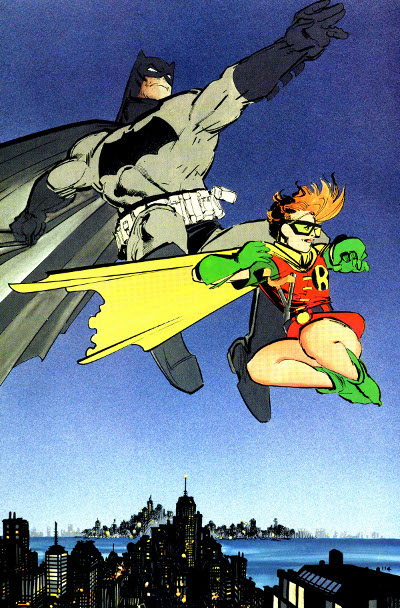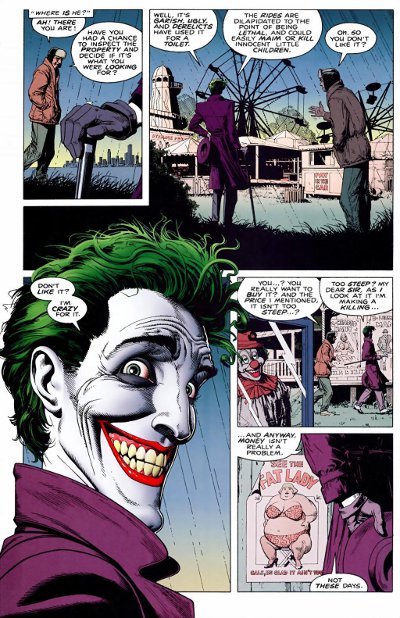In the wake of the disastrous Batman v Superman: Dawn of Justice*, I thought it was time to take a look back at Batman, so I went out and read a bunch of the more famous and lauded comics as well as a few peripheral bits of media. My experience with comic books and graphic novels is limited, to be sure, but I did briefly go through a phase in the early 1990s where I read a bunch of stuff, including some Batman and Superman. These weren’t particularly memorable, though there was that whole Death of Superman thing (and the subsequent return) that was pretty hard to miss. I also read a bunch of them newfangled Image comics, but believe it or not, my focus at the time was more on licensed properties like The Terminator, Aliens, and Predator (and come to think of it, Batman versus Predator was nestled in there somewhere). More recently, friends turned me on to the likes of Locke & Key and Morning Glories, but not so much superhero comics. All of which is to say that you should probably take what follows with the appropriate boulder of salt.
- The Dark Knight Returns – A 4 issue miniseries set in an alternate, dystopian Gotham City where a 55 year old Batman snaps and comes out of retirement to deal with a growing gang menace as well as some old foes (and while he’s at it, friends). Grim and gritty, this is probably one of the most influential comics of all time. Also, probably one of the most overrated. Coming at this from the outside (and 30 years later), it seems like a dramatic pendulum swing, the polar opposite of the campy 60s Adam West Batman TV series. Perhaps a necessary change, but almost certainly an overcorrection. Written by Frank Miller with art from Miller and Klaus Janson, I found the book to be a bit of a slog. Miller’s writing is pretty text heavy, with a clunky overuse of cross-cutting (or whatever the comic book equivalent to that is) and relying a little too heavily on an extended critique of the news media. The artwork feels kinda sloppy and jumbled, with some exceptions. The use of a 16 panel grid sometimes leads to highly repetitive and awkward visual cues. It sometimes feels like the art isn’t finished. I’m guessing the washed out tone was intentional, but aside from the new Robin character, a lot of this feels a little too muddled. The one visual thing that did work for me are the striking splash pages.
Perhaps because of the repetitive grid preceding them, the splash pages have a high impact and the art is usually much more distinctive and focused. They’re doled out sparingly, but that only increases their effectiveness. From what I can tell, this is one of the influential things about this book, though I don’t know enough to say for sure… Storywise, there actually isn’t much going on here. It’s all just an excuse for Miller to indulge in graphic excess, relying too much on the shock value of having, say, Selina Kyle be a hooker or Batman riding up to criminals in a tank or something. It’s not so much that the story is dark that’s the problem (though it does feel excessive), it’s that there isn’t much of a story at all, it’s just a flimsy pretense to go dark. Reading this after seeing Batman v Superman: Dawn of Justice*, I’m guessing that Zack Snyder was majorly influenced by this book. His movie has a similar disjointed structure (except that it’s a lot worse on screen that it is on the page). Overall, glad I read this, but I can’t see myself revisiting it much.
- Batman: The Killing Joke – This short graphic novel, written by Alan Moore with art from Brian Bolland, is more like it. Once again, we’re greeted with stultifying darkness, but here, at least, it works. The art is also quite beautiful and much more appropriate for the story. Speaking of which, there actually is a story. A very dark, very gruesome story, to be sure, but at least something that makes sense. There’s shock value here, but that’s a means to an end, not the end in itself.
What’s more, the art seems singularly focused on moving the story along. It’s not an afterthought or formality, it’s specifically designed. Everything feels deliberate and planned, like Moore and Bolland are actually taking advantage of the medium (imagine that) to, for example, provide a surprise when you turn the page. There is little of this in Miller’s TDKR. There are some strange choices here, notably the idea of showing the Joker’s origin (though I suppose you can retcon it as being another made up story, a la Heath Ledger’s Joker), but it’s all something I’m willing to go with. To continue the pendulum metaphor from above, we’re still on that grim and gritty swing, but we’re starting to fall back down towards the equilibrium. Not by much, but enough. I found out after I read this that apparently there’s some sort of argument about the ending, whether or not someone is killed. In some ways, the book is ambiguous, in others, it’s visually very clear. The artwork is so generally well done that I have to take this as being intentional. Sorry, trying to avoid spoilers here, but this is well worth checking out.
- Batman: Year One – Another 4 issue run written by Frank Miller, this one is illustrated by David Mazzucchelli, and thus avoids much of the sloppiness I perceived in TDKR. Miller’s script is also toned down a bit here too, retaining the darkness but relying less on shock value and more on actual story, which I appreciated much more. It’s a retelling of Batman’s origin, and his initial forays into crime-fighting. Much of this is focused on Batman’s failures, to be sure, but hey, one scene follows another in a generally logical progression that actually makes sense. Way to go, Miller! The art is generally better than TDKR as well, and some of the imagery does feel quite iconic (if not as great as Killing Joke). It’s clear that some of this inspired Christopher Nolan’s Batman Begins, even if it’s not a one-to-one adaptation.
- Batman: The Animated Series – This is basically my Batman. I had watched some of the 60s show and I’d seen the Tim Burton Batman movie, but this series, more than anything else, is what made me love Batman as a character. I noticed that this was on Amazon Prime streaming, so I threw on a few episodes, hoping it would live up to my memory. I’m happy to report that it has held up incredibly well. This show is fantastic. From the unique German expressionism/Art Deco visuals, to the voice acting, to the well paced and plotted stories, this gets everything just right. One of the many reasons the show works so well is that it, like its source material, is episodic in nature. This causes so much angst in filmic portrayals because the filmmakers are always trying to cram so much into their 2 hour limit that they often have trouble balancing it all together. The series does not need to worry about such things, and manages to stay very focused and on point throughout. The show was created for kids, but it has a surprisingly ambitious streak, such that adults can still get a lot out of this. Take, for instance, the pure visual storytelling on display in the opening credits – a heist is foiled by Batman, no dialogue, just visuals. While the tone is not as dark as the other things in this post, it was a welcome respite, while not descending into ridiculous camp. They struck a perfect balance here, and it’s the sort of thing that I think everyone enjoys, including the hardest of hard-core comic fans and normal people alike. I’m really looking forward to watching more of these…
- The Caped Crusade: Batman and the Rise of Nerd Culture by Glen Weldon – This recently released cultural history of Batman, tracing him from his origins up through current incarnations, was quite enlightening. Weldon (of Pop Culture Happy Hour fame) clearly has a love of the character that runs deep, and he has done his homework. He posits an interesting cycle for the Caped Crusader, from noir detective to kid and family friendly superhero and back again, it seems like my pendulum metapahor earlier in this post is particularly apt for this character. As evidenced by this post, I’m no expert, but it does seem like Weldon has taken a pretty comprehensive look at the character on both the pages of comic books as well as other adaptations. If you’re a fan of Batman, this is well worth checking out.
And that just about covers it. Up next on the Batman front: Batman: The Long Halloween, which seems like something I might want to save for later reading…
* This is the actual title of the movie. Someone actually thought that up, and then more people actually approved it and put hundreds of millions dollars behind it.

